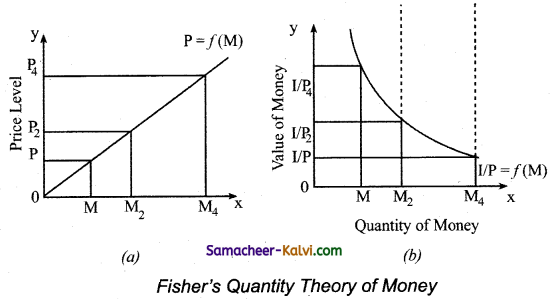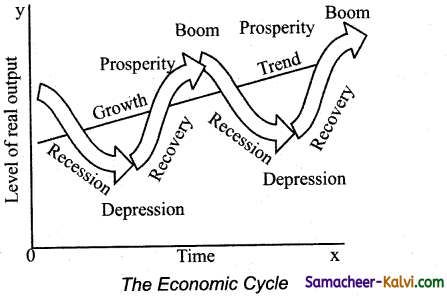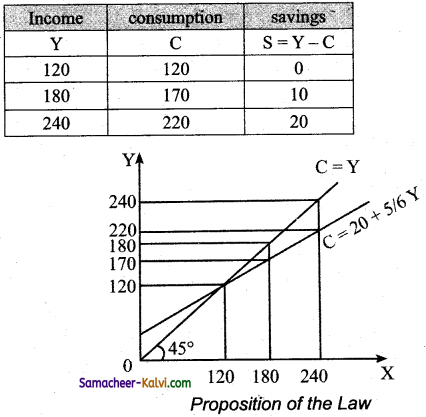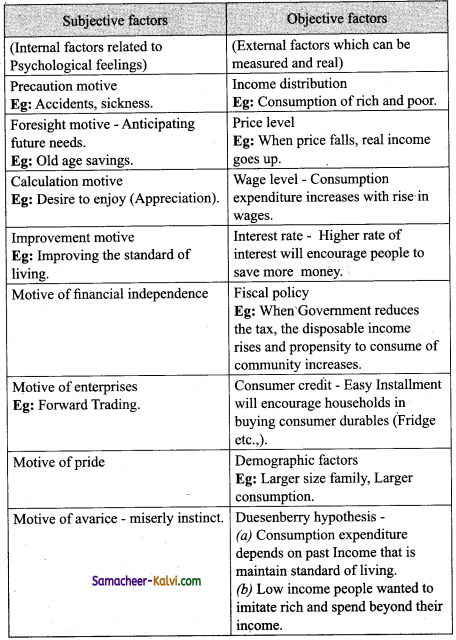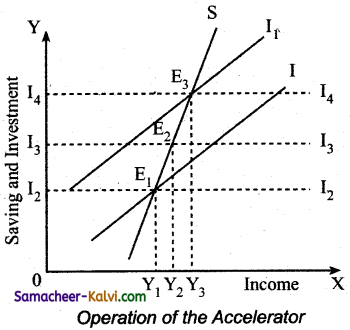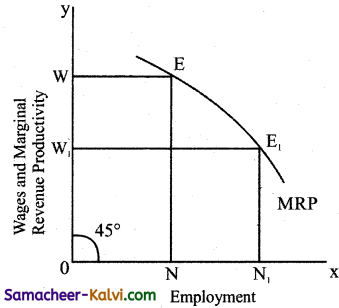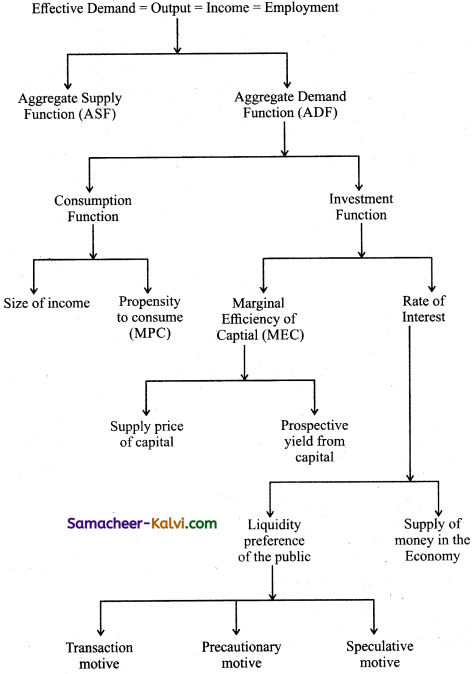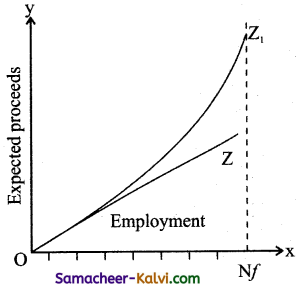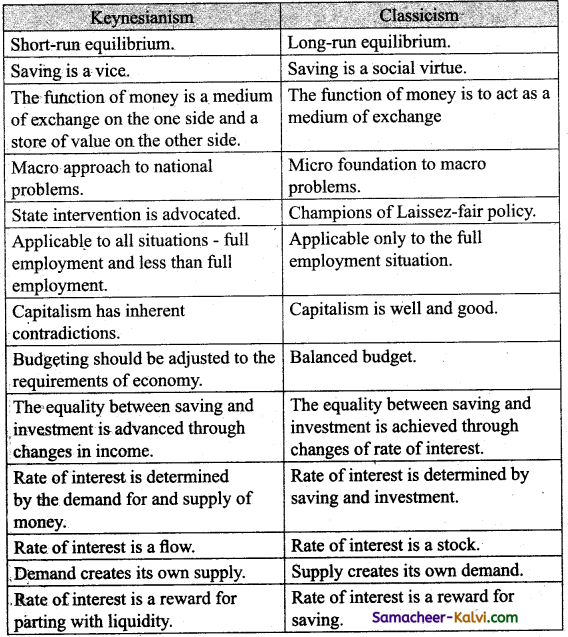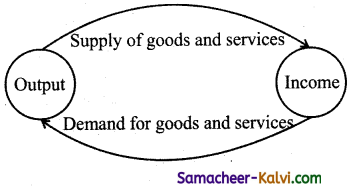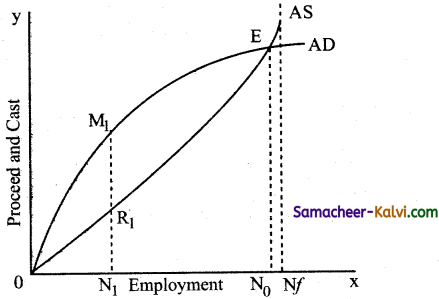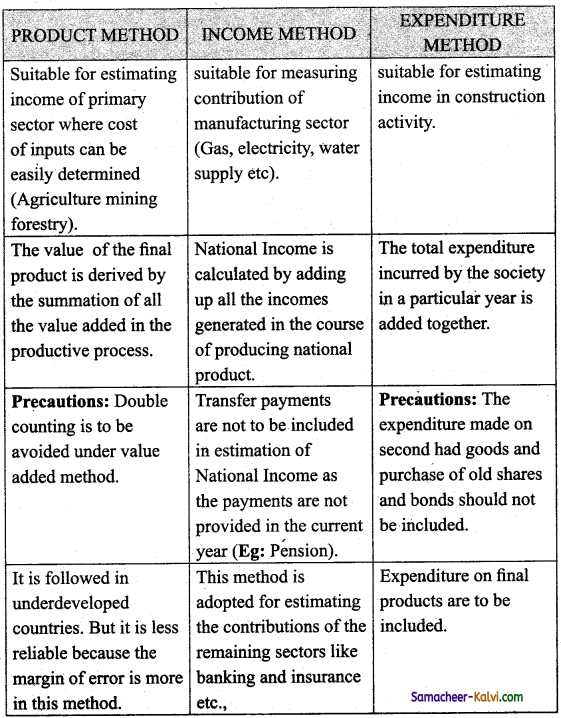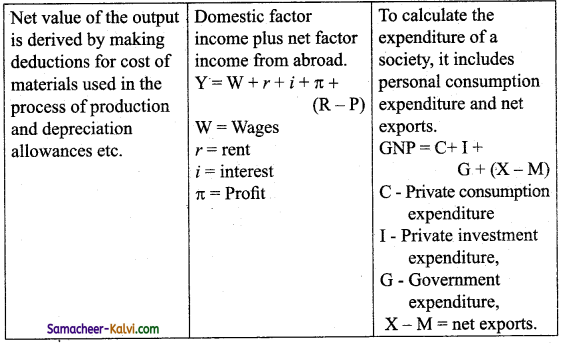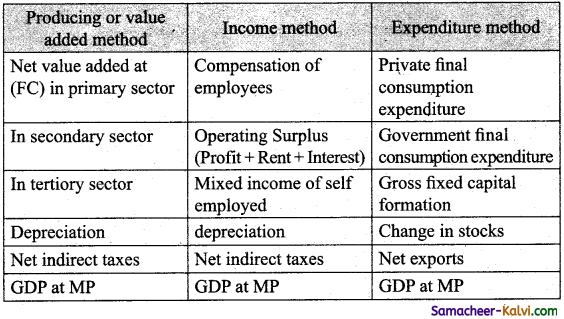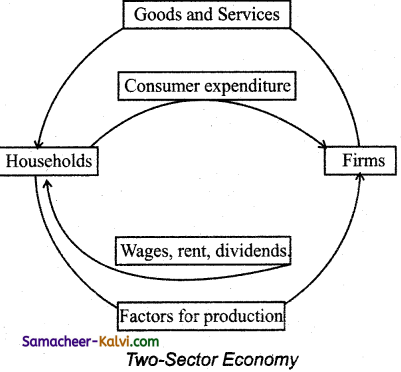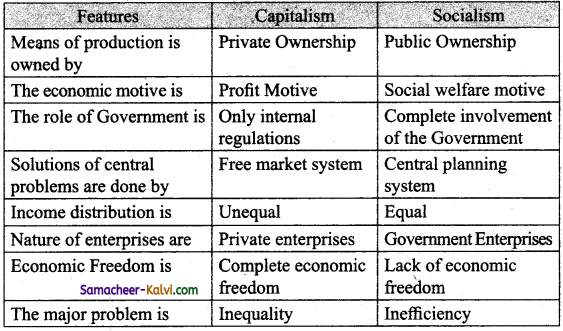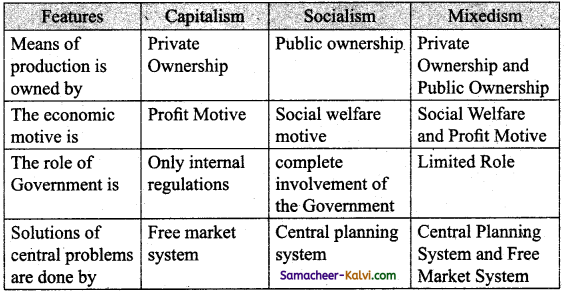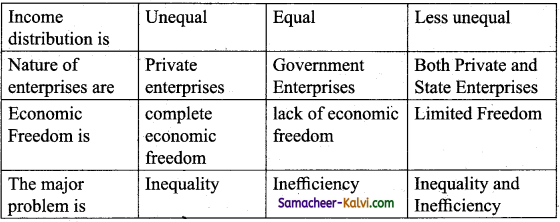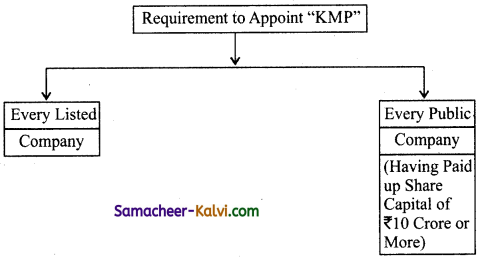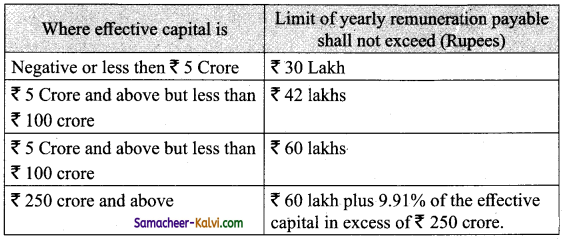TN State Board 12th Economics Important Questions Chapter 6 Banking
Question 1.
Define Commercial banks.
Answer:
It refers to a bank or a division of a large bank, which more specifically deals with deposit and loan services provided to corporations or large/middle sized business.
Question 2.
What is credit creation?
Answer:
Credit creation is done to provide more funds for developments projects. It leads to increased production, employment, sales, prices and faster economic development.
![]()
Question 3.
Define Central bank.
Answer:
The National bank which provides Banking and Financial services for the Government and Banking system. It also implements monetary policy of the government including issuing of currencies.
Question 4.
Distinguish between CRR and SLR.
Answer:
|
CRR |
SLR |
| Cash Reserve ratio. | Statutory Liquidity Ratio. |
| The commercial bank has to maintain reserve with the RBI is called CRR. | The amount which a bank has to maintain in the form of cash or gold or approved securities is called SLR. |
| CRR regulates the flow of money in the economy. | SLR ensures the solvency of the banks. |
Question 5.
Write the meaning of Open market operations.
Answer:
The central bank starts the purchase and sale of Government securities in the money market. When the banks and private individuals purchase these securities they have to make payments for these securities to the Central Bank.
![]()
Question 6.
What is rationing of credit?
Answer:
This is the oldest method of credit control, it regulates and controls the purpose for which the credit is granted by commercial banks.
Question 7.
Mention the functions of agriculture credit department.
Answer:
- To maintain expert staff to study all questions on agricultural credit.
- To provide advice to Central and State Governments, State Co-operative banks and other banking activities.
- To finance rural sectors in the business of agricultural credit and to co¬ordinate their activities.
Question 8.
Write the mechanism of credit creation by commercial banks.
Answer:
The power of commercial bank to create deposits through expanding their loans and advances is known as credit creation. It refers to bank loans and advances. As credit creation the banks make a net addition to the total supply of money in the economy. The banks have the power to expand or contract demand deposits through granting loans and advances and acquiring other assets.
![]()
Question 9.
Give a brief note on NBFI.
Answer:
- It is a financial institution which does not have full banking license and it is not supervised by the central bank.
- NBFI receive deposits and give loans. They mobilize people’s savings and use the funds to finance expenditure on investment activities.
- NBFI operate in both the money and capital markets.
Question 10.
Bring out the methods of credit control.
Answer:
The two methods are:
(i) Quantitative
(ii) Qualitative
(i) (General) Quantitative credit control measures:
(a) Bank rate
(b) Open market operations
(c) Variable cash reserve ratio
(ii) (Selective) Qualitative credit control measures:
(a) Rationing of credit
(b) Direct action
(c) Moral suasion
(d) Publicity
(e) Regulation of consumer credit
(f) Marginal requirements.
![]()
Question 11.
What are the functions of NABARD?
Answer:
National bank for agriculture and rural development:
- It plays an apex role from RBI with regard to agriculture credit
- It acts as a re – financing institution for all kinds of production and investment. Credit to agriculture small scale and cottage industries to promote rural development.
- It gives short – term loans to SCB, RRB and LDB.
- It gives long – term loans to state government and to any institutions approved by Central Government.
- It co-ordinates the activities of Central and State Governments and the Planning Commission.
- It will inspect, RRB and Co-operative banks. It also promotes research on Agriculture and Rural Developments.
Question 12.
Specify the functions of IFCI.
Answer:
Industrial Finance Corporation of India provides assistance to the industrial concern.
- It gives long-term loans in Indian and Foreign currencies.
- Under writing of Equity, Preference and Debenture issues and also subscribing.
- Guaranteeing the deferred payments in respect of machinery from India and abroad.
- Guaranteeing of loans raised in foreign currency from foreign Financial Institutions.
- It also provides Financial assistance on concessions for setting up industrial projects is less developed districts.
![]()
Question 13.
Distinguish between Money market and Capital market.
Answer:
| Money market |
Capital market |
| It’s a mechanism through which short term funds are loaned and borrowed. | It is a part of financial system which is concerned with raising capital and other long term investments. |
| It handles the purchase, sale and transfer of short term credit instruments. Institutions which require short term funds in the money market are commercial banks etc., | The market where investment instruments like bonds, equities and mortgages are traded. |
Question 14.
Mention the objectives of demonetisations.
Answer:
Objectives of Demonetisation:
- Removing Black Money from the country
- Shopping of corruption
- Shopping terror funds
- Curbing fake notes.
![]()
Question 15.
Explain the role of Commercial Banks in economic development.
Answer:
Role of commercial banks in Economic development:
(i) Capital formation:
The Economic development depends on the capital formation. Banks offer very attractive schemes to encourage the people to save their money.
(ii) Creation of credit:
To provide more funds for development projects, bank create credit which leads to increase in production, employment, sales etc.,
(iii) Channelizing the funds towards productive investment:
Banks invest its savings for productive purposes. The savings are allocated for various sectors to increase productivity and economic development.
(iv) Encouraging right type of industries:
The banks grant loans and advances to manufacturers, they in turn increase the productivity and industrialization helps to increase national income and economic development.
(v) Bank monetize debt:
Manufacturers cannot increase their sales without selling goods. But when they sell on credit basis, capital invested will be locked. As banks are lending money by discounting bill of exchange, business concerns are able to carry out the economic activities without any interruption.
(vi) Finance to the Government:
Government is acting as the promoter of industries in underdeveloped countries. Banks provide long-term credit to government by Government securities and short term finance by purchasing treasury bills.
(vii) Employment generation:
Banking industry has been widened by nationalization and creates new employment opportunities
.
(viii) Banks promote entrepreneurship:
Banks, by inducing new entrepreneurs to take up new well-formulated projects. They also . provide 100% credit. Thus commercial bank help for the development of the country.
![]()
Question 16.
Elucidate the functions of Commercial Banks.
Answer:
Functions of commercial banks:
→ Primary functions
→ Secondary functions .
→ Other functions
Primary Functions:
(a) Accepting deposits: Demand and time deposits
→ Demand deposits can be withdrawn without any prior notice to the bank by the individuals.
→ Time deposits are made for certain period of time. Banks pay higher interest.
(b) Advancing loans:
Commercial banks grant loans in the form of overdraft etc.
Secondary functions: Three categories.
Agency functions: Commercial banks are the agents for its customers.
(a) Collecting cheques: Commercial bank collect cheques and bills for exchange of their customers.
(b) Collecting income: They collect dividends, pensions, salaries etc., on behalf of their customers and a credit voucher is sent to customers.
(c) Paying expenses: Commercial banks make payments of telephone bills etc.
General Utility Functions: They are
(a) Providing locker facilities: Bank provides locker facilities for safe custody of jewels etc., of its customers.
(b) Issuing traveler’s cheques: To travel safely outside without any fear, bank issues travelers cheques.
(c) Dealing in foreign exchange: It helps by providing foreign exchange to businessmen who do exports and imports.
Transferring funds:
Transferring funds from one bank to another through draft, E-transfer etc.
Letter of credit:
Commercial banks issue letter of credit to customers to certify their credit worthiness.
(a) Underwriting securities: Due to the faith of customers, they buy securities underwritten by banks.
(b) Electronic Banking: It includes services, such as debit cards, credit cards, and Internet banking.
Other functions:
(a) Money supply: The commercial banks help to increase the money supply without printing additional money, the supply of money is increased.
(b) Credit creation: It is multiplication of loans and advances. The loans offered by banks are more than the deposits.
(c) Collections of statistics: The commercial banks publish and collect statistics relating to trade, commerce and industry. So they advice the public authorities and customers on financial matters.
![]()
Question 17.
Describe the functions of Reserve Bank of India.
Answer:
RBI is India’s Central Banking Institution which controls monetary policy of the Indian rupee.
(i) Monetary authority:
It controls the supply of money in the economy to stabilize exchange rate, maintain balance of payment, control inflation etc.
(ii) The issuer of currency:
RBI is the sole authority to issue currency and controls fake currency.
(iii) The issuer of Banking licenses:
All banks should obtain license from RBI according to section 22 of Banking Regulation Act.
(iv) Banker to the Government:
It provides short term credit and manages all issues of Government loans and also advices the Government on Financial subjects.
(v) Banker’s bank:
It provides loans, accepts deposits and rediscount the bills of banks.
(vi) Lender of the last resort:
The commercial banks borrow money from the RBI during the time of crisis with collateral securities.
(vii) Act as a clearing House:
For settlement of banking transactions, RBI manages 14 clearing houses to facilitate exchange instruments and processing of payment instructions.
(viii) Custodian of Foreign exchange reserves:
RBI acts as a custodian of FOREX. It buys and sells foreign currency to maintain the exchange rate of Indian rupee vs Foreign currencies.
(ix) Regulator of economy:
It monitors GDP. Inflation etc., and also controls the money supply in the system.
(x) Managing Government securities:
RBI administers investments in institutional when they invest minimum portions of their assets/liabilities in Government securities.
(xi) Regulator and supervisor of payment and settlement systems:
PSS Act gives authority to RBI for payment and settlement systems in the country.
(xii) Developmental role:
It gives quality banking system in India. It also provides a wide range of promotional functions to support National objectives. It also provides financial literacy.
(xiii) Publisher of monetary data and other data:
RBI collects and publishes all essential data regularly.
(xiv) Exchange manager and controller:
RBI is a Indian representative of IMF.
(xv) Banking Ombudsman scheme:
This was introduced in 1995. According to this scheme complains in any order can be filed on the decisions of the banks.
(xvi) Banking codes and Standards board:
The codes and standards are based on established global practices to measure the performance of the banks. RBI has set up Banking Codes and Standards Board of India (BCSBI).
![]()
Question 18.
What are the objectives of Monetary Policy? Explain.
Answer:
The monetary policy in developed economies has to serve the function of stabilization and maintaining proper equilibrium in the Economic system.
(i) Neutrality of money:
According to economists like Wicksteed and Robertson of Chief exponents of neutral money. According to them monetary authority should aim at neutrality of money in the economy.
(ii) Exchange rate stability:
This was the main objective. It is also known as “Expand currency and credit when gold is coming in, contract currency and credit when gold is going out”. Due to this exchange rate stability will be maintained.
(iii Price stability:
It is the main objective of monetary policy according to Keynes stable prices will repose public confidence. So there will be prosperity and welfare in the community.
(iv) Full employment:
It is the main goal of monetary policy, because unemployment is dangerous economically wasteful.
(v) Economic growth:
Economic growth is the process whereby the real Per Capita Income of a country increases over a long period of time. So Monetary policy should promote sustained Economic growth.
(vi) Equilibrium in the balance of payments:
During post war years this became significant. Increasing of deficit in the balance of payments reduces the ability of an economy to achieve other objectives. So monetary authority makes efforts maintain equilibrium in the Balance of payments.
![]()
Multiple Choice Questions:
Question 1.
A Bank is a:
(a) Financial institution
(b) Corporate
(c) An Industry
(d) Service institutions
Answer:
(a) Financial institution
Question 2.
A Commercial Bank is an institutions that provides services:
(a) Accepting deposits
(b) Providing loans
(c) Both (a) and (b)
(d) None of the above
Answer:
(c) Both (a) and (b)
Question 3.
The Functions of commercial banks are broadly classified into:
(a) Primary Functions
(b) Secondary functions
(c) Other functions
(d) a, b, and c
Answer:
(d) a, b, and c
![]()
Question 4.
Bank credit refers to:
(a) Bank Loans
(b) Advances
(c) Bank loans and advances
(d) Borrowings
Answer:
(c) Bank loans and advances
Question 5.
Credit creation means:
(a) Multiplication of loans and advances
(b) Revenue
(c) Expenditure
(d) Debt
Answer:
(a) Multiplication of loans and advances
Question 6.
NBFI does not have:
(a) Banking license
(b) government approval
(c) Money market approval
(d) Finance ministry approval
Answer:
(a) Banking license
![]()
Question 7.
Central bank is ______ authority of any country.
(a) Monetary
(b) Fiscal
(c) Wage
(d) National Income
Answer:
(a) Monetary
Question 8.
Who will act as the banker to the Government of India?
(a) SBI
(b) NABARD
(c) ICICI
(d) RBI
Answer:
(d) RBI
Question 9.
Lender of the last resort is one of the functions of:
(a) Central Bank
(b) Commercial banks
(c) Land Development Banks
(d) Co-operative banks
Answer:
(a) Central Bank
![]()
Question 10.
Bank Rate means:
(a) Re-discounting the first class securities
(b) Interest rate
(c) Exchange rate
(d) Growth rate
Answer:
(a) Re-discounting the first class securities
Question 11.
Repo Rate means:
(a) Rate at which the Commercial Banks are willing to lend to RBI.
(b) Rate at which the RBI is willing to lend to commercial banks.
(c) Exchange rate of the foreign bank.
(d) Growth rate of the economy.
Answer:
(b) Rate at which the RBI is willing to lend to commercial banks.
Question 12.
Moral suasion refers:
(a) Optimization
(b) Maximization
(c) Persuasion
(d) Minimization
Answer:
(c) Persuasion
![]()
Question 13.
ARDC started functioning from:
(a) June 3, 1963
(b) July 3, 1963
(c) June 1, 1963
(d) July 1, 1963
Answer:
(d) July 1, 1963
Question 14.
NABARD was set up in:
(aj July 1962
(b) July 1972
(c) July 1982
(d) July 1992
Answer:
(c) July 1982
Question 15.
EXIM bank was established in:
(a) June 1982
(b) April 1982
(c) May 1982
(d) March 1982
Answer:
(d) March 1982
![]()
Question 16.
The State Financial Corporation Act was passed by:
(a) Government of India
(b) Government of Tamilnadu
(c) Government of Union Territories
(d) Local Government
Answer:
(a) Government of India
Question 17.
Monetary policy his formulated by:
(a) Co-operative banks
(b) Commercial banks
(c) Central Bank
(d) Foreign banks
Answer:
(c) Central Bank
Question 18.
Online Banking is also known as:
(a) E-Banking
(b) IOnternet banking
(c) RTGS
(d) NEFT
Answer:
(b) IOnternet banking
![]()
Question 19.
Expansions of ATM:
(a) Automated Teller Machine
(b) Adjustment Teller Machine
(c) Automatic Teller mechanism
(d) Any Time Money
Answer:
(a) Automated Teller Machine
Question 20.
2016 Demonetization of currency includes denominations of:
(a) ₹ 500 and ₹ 1000
(b) ₹ 1000 and ₹ 2000
(c) ₹ 200 and ₹ 500
(d) All the above
Answer:
(a) ₹ 500 and ₹ 1000
![]()
Samacheer Kalvi 12th Economics Notes Chapter 6 Banking
→ Demand deposits: It is the deposit that can be withdrawn by individuals without any notice to the bank.
→ Letter of credit: Commercial banks issue letter of credit to their customers to certify their credit worthiness.
→ Primary deposit: When customer gives cash to the bank and the bank creates a book debt in his name called a deposit.
→ Time deposits: Deposits made for certain period of time.
→ E-Banking – Electronic banking: The services such as debit cards, credit cards and internet banking.
→ Trancter’s cheques: Cheques issued for travelling outside the country.
→ Banking Ombudsman scheme: Introduced in 1995. The complaints can appeal to the Ombudsman against the decisions of bank.
→ Moral Suasion: RBI gives advice, request and asks commercial banks to co-operate with RBI.
→Paying expenses: Commercial banks make the payments of various obligation of customers such as telephone bills etc.,
→ Money supply: Important function of commercial banks to increase the supply of money.
→ Banking: “Commercial Banks are the institutions that make short term loans to business and in the process create money ” – Culbertson
→ Commercial banks: Commercial banks can be described as a financial institutions, that offers basic investment products like savings account.
![]()
→ Role of banks in economic development:
“An organization whose principal operations are concerned with the accumulations of the temporarily idle money of the general public for the purpose of advancing to others for expenditure”. – KENT
→ Central bank:
(i) “Banking system in which a single bank has either complete Control or a residuary monopoly of note issue ” – Smith
(ii) H.A. Shaw defines central bank as “ Bank which controls credit Monetary policy: It is the macro economic policy laid down by the central bank – It involves management of money supply and interest rate and is the demand side economic policy used by the government of a country to achieve macro economic objectives like inflation, consumption, growth and liquidity.
→ NBFI – Non-Banking Financial Institution
→ UTI – Unit Trust of India
→ RBI – Reserve Bank of India (Central bank)
→ FOREX – Foreign Exchange Reserves
→ FEMA – Foreign Exchange Management Act
→ PSS Act – The Payment and Settlement Systems Act
→ IMF – International Monetary Fund
→ CR – Cash Reserve Ratio
→ SLR – Statutory Liquidity Ratio
→ RR – Repo Rate
→ RRR – Reserve Repo Rate
![]()
→ ARDC – The Agricultural Refinance Development Corporation
→ RRB – Regional Rural Bank
→ NABARD – National Bank for Agriculture and Rural Development
→ GOI – Government of India
→ CBD – Central Board Directors
→ IFCI – Industrial Finance Corporation of India
→ ICICI – Industrial Credit and Investment Corporation of India
→ IDBI – Industrial Development Bank of India
→ SFC – State Financial Corporations
→ SIDS – State Industrial Development Corporation
→ BCSBI – Banking Codes and Standards board of India
→ IFCI – Industrial Finance Corporation India
→ IDBI – Industrial Development Bank of India
→ SFC – State Financial Corporation
→ SIDCO – State Industrial Development Corporation
→ NEFT – National Electronic Fund Transfer
→ RTG – Real Time Gross Settlement
→ ATM – Automated Teller Machine
